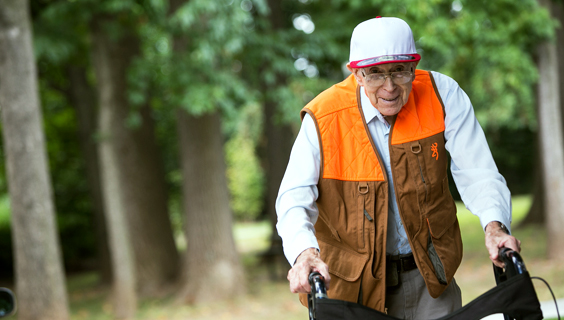One moment you’re carrying the laundry basket to the washer, and the next, you trip and find yourself on the floor. If you’re lucky, you’ll get up, dust yourself off, and carry on with your day. However, even a minor misstep can lead to a life-altering injury. Understanding how to prevent falls is crucial for older adults to maintain their health, activity level, and independence.
The Risk of Falls
Falls can happen to anyone at any age, but older adults face a significantly higher risk for serious injuries. According to the CDC, one in four people over 65 experiences a fall each year. Approximately 3 million older adults visit emergency rooms due to falls, and about 1 million require hospitalization. Falls can lead to hip fractures and severe brain injuries, significantly increasing the risk of disability and even death.
As we age, our bodies undergo various changes that can contribute to this heightened risk for older adults. Factors such as reduced strength, balance issues, and vision impairments can all play a role in increasing the likelihood of a fall. Additionally, certain medications may have side effects that can further compromise stability. Therefore, understanding and addressing these risks is essential for preventing falls.
5 Steps to Prevent Falls
1. Identify Hazards in the Home
Falls frequently occur in and around the home, especially as we age. The National Council on Aging provides a checklist to help increase your home safety. Conduct a thorough walkthrough, starting outside and moving through each room, looking for potential hazards:
- Sturdy Steps and Handrails: Ensure steps inside and outside are stable and equipped with handrails to assist with balance.
- Lighting: Make sure hallways and stairs are well-lit to avoid hidden obstacles.
- Accessible Light Switches: Light switches should be easy to locate and operate, ideally at both the top and bottom of staircases.
- Clutter-Free Areas: Keep high-traffic areas, especially stairs, free of clutter like shoes and books that could cause tripping.
- Clear Pathways: Maintain clear pathways that are wide enough for easy movement, ensuring nothing obstructs daily activities.
- Secure Rugs and Mats: Ensure rugs and mats are secured to prevent slipping; consider removing them if they pose a hazard.
- Tidy Loose Wires: Tidy up loose wires or tripping hazards with ties or tape to keep floors clear.
If someone in your home has recently fallen, consider having an occupational therapist assess your space for safety improvements. Their expertise can provide tailored recommendations for enhancing safety.
2. Make Modifications for Safety
Don’t wait for an accident to make changes. Simple modifications can significantly lower fall risks for older adults:
- Install Nightlights: Use nightlights and motion-activated lights to enhance visibility throughout the home, especially in hallways and bathrooms.
- Remove Weather Hazards: Promptly clear snow and ice from pathways to prevent slips during winter months.
- Check Rug Corners: Watch for rug corners that might curl up and pose tripping hazards; secure them or replace them with nonslip options.
- Strong Handrails: Ensure all handrails can support a person’s full weight, providing stability when moving up or down stairs.
Bathroom Safety
Since approximately 80% of home falls occur in the bathroom, take special precautions there:
- Walk-in Bathtubs: Consider installing walk-in bathtubs or curbless shower stalls to eliminate high thresholds that could lead to falls.
- Nonslip Mats: Use nonslip mats on all slippery surfaces, including tile floors, bathtubs, and shower floors.
- Install Benches: Adding benches in showers can provide a safe place to sit while bathing.
- Grab Bars: Place grab bars in showers and near toilets for additional support.
- Well-Lit Bathrooms: Ensure bathrooms are well-lit to prevent accidents when using the facilities.
3. Adjust Behavior to Avoid Falls
Changing daily habits can help prevent falls. Here are some practical strategies:
- Organize Frequently Used Items: Keep frequently used items within easy reach, especially in the kitchen and bathroom, to minimize the need for stretching or bending.
- Avoid Step Stools: Avoid using step stools or ladders to reach high shelves; instead, ask for assistance from a friend or family member.
- Maintain Clear Sight on Stairs: When using stairs, ensure you can see your feet. Carrying items that block your view can be dangerous.
- Use Handrails: Always utilize handrails when navigating stairs for added support.
- Wear Proper Footwear: Avoid poorly fitting shoes, which are linked to an increased risk of falling. Wear shoes and socks that fit well and provide good traction, especially on slick surfaces.
Pet owners should also be mindful of their furry friends. Keeping an eye on pets while moving around the house can prevent accidental trips and falls, particularly in low-light conditions.
4. Recognize High-Risk Individuals
Some individuals are more prone to falls due to age, behaviors, or medical conditions. Chronic issues such as high blood pressure, arthritis, diabetes, and Parkinson’s disease can increase fall risk for older adults. Additionally, certain medications may contribute to this risk.
To mitigate these factors:
- Healthy Lifestyle Choices: Maintain a healthy diet, stay hydrated, and remain physically active. Exercise can improve strength and balance, reducing the risk of falls.
- Meal Assistance: If someone in your household struggles with meal preparation, consider home delivery services or meals from nearby senior centers to ensure proper nutrition.
- Balance and Strength Exercises: Engage in simple balance and strength-building exercises to help reduce fall risk. Community centers often offer classes designed for seniors.
5. Regular Doctor Visits to Address Risks
Taking care of your health is vital for fall prevention. Older adults should have regular vision checks and ensure their doctors are aware of all medications they’re taking. Regular health check-ups can help identify any underlying issues that may contribute to fall risk.
- Medication Reviews: Discuss medications with your healthcare provider to understand their side effects and interactions that may increase fall risk for older adults.
- Vision Assessments: Regular eye exams can help catch vision problems early, allowing for timely corrections, such as new glasses.
Conclusion
By implementing these strategies, you create a safer living environment for older adults. Prevention is key; small changes can make a big difference in reducing the risk for older adults. Educate family members about safety and encourage participation in exercises that improve balance and strength. Together, you can foster a safer space that promotes independence and enhances overall quality of life. Prioritizing fall prevention today leads to a healthier, safer tomorrow.

